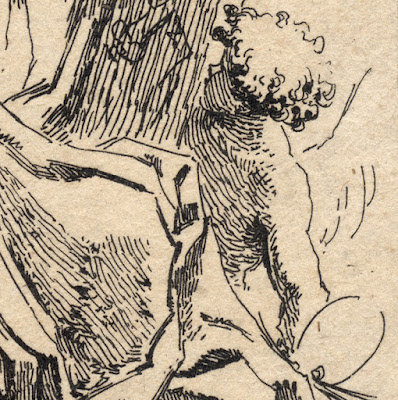Philips
Galle (aka Philippe Galle; Philippus Gallaeus) (1537–1612)
“Lion Hunt on Horseback”, 1578, from the series, “Hunting Parties”
(aka “Venationes Ferarum, Avium, Piscium” (transl. “With wild beasts, birds,
fish”), after Jan van der Straet (aka Joannes Stradanus; Ioannes Stradanus)
(1523–1605).
Note: according to the curator of the British Museum’s explanation
about the series, this impression is from the first edition of 43 unnumbered
plates that were all engraved by Philips Galle with a dedication page to Cosimo
de Medici. After this edition the series was expanded to 104 plates engraved by
A. Collaert, J. Collaert, C. Galle I and C. de Mallery with a dedication page
to the jurist Henricus van Osthoorn en Sonnevelt (see http://www.britishmuseum.org/research/collection_online/collection_object_details.aspx?objectId=1619537&partId=1&people=93957&peoA=93957-2-70&page=1
and A. Baroni and M. Sellink, “Stradanus
1523-1605: Court artist of the Medici”, exh.cat. Groeningemuseum Brugge
2008-2009, Turnhout, 2012, pp.245–58, cat.nos.32–49.). In the later expanded
edition of 104 plates, this plate was numbered “17” on the lower left.
Engraving on laid paper with margins as published in the first
edition of 1578 (?).
Size: (sheet) 25.4 x 33.2 cm; (plate) 21.8 x 29.8 cm; (image
borderline) 20.2 x 29.5 cm
Lettered within image borderline at lower left: “Iohan Stra. inve.
/ Phls Galle fe.”
Lettered below the image borderline: “Sic venatoris lenti Leo
terga fatigat, 4 Cuspide du crebri, tumida du fernet ab ira.”
State: ii (of iii?) with the added numeral, “4”, but before the
addition of the number, “17”, of state iii.
TIB 5601.104:4 (Walter L Strauss & Arno Dolders [Eds.] 1987,
“The Illustrated Bartsch”, vol. 56, Supplement, p. 404); New Hollstein (Dutch
& Flemish) 424.III (Johannes Stradanus); New Hollstein (Dutch &
Flemish) 522.III (Philips Galle); Baroni Vannucci 1997 693.17 (Alessandra
Baroni Vannucci 1997, “Jan van der Straet, detto Giovanni Stradano, flandrus
pictor et inventor”, Milan, Jandi Sapi Editori)
The British Museum offers the following description of this print
from the later edition when the plate was numbered:
“Plate numbered 17, Lion Hunt on Horseback; at centre, a lion is
trampled by men on horseback, armed with spears, while another lion attacks the
central horseman from behind, who attempts to retaliate with a dagger. Engraving” (http://www.britishmuseum.org/research/collection_online/collection_object_details.aspx?objectId=1619831&partId=1&searchText=galle+lion+hunt&page=1)
Condition: luminous lifetime impression (see explanation above).
There is a printer’s crease (i.e. a crease occurring during the printing
process) running through the foreground lion and the margins of the print shows
light signs of handling. There is a small tear (1 cm) in the upper right margin
which has been addressed as the print is laid onto a support sheet of
conservator’s fine archival/millennium quality washi paper.
I am selling this exceptionally rare, engraving from 1578
for a total cost of AU$256 (currently US$202.45/EUR170.77/GBP157.20 at the time
of this listing) including postage and handling to anywhere in the world.
If you are interested in purchasing this important print foreshadowing Ruben's "The Lion Hunt" (1621),
please contact me (oz_jim@printsandprinciples.com) and I will send you a PayPal
invoice to make the payment easy.
This print has been sold.
I suspect that most folk looking at this engraving would be
reminded of Peter Paul Rubens’ famous painting, “The Lion Hunt” (1621). Beyond
the fact that both compositions feature the same exotic subject of lions being
hunted—hopefully a practice that will disappear forever—for me the connection
that brings to mind Ruben’s painting is the pattern of radiating lines created
by lances pointing towards the centre lion in both images set against the
writhing rhythms of horses, lions and men.
What might surprise some viewers is that this
print was executed 43 years before Rubens made his painting.























































